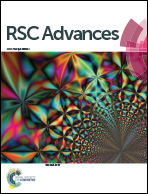Anodic stripping voltammetry of anti-Vi antibody functionalized CdTe quantum dots for the specific monitoring of Salmonella enterica serovar Typhi†
Abstract
Recent trends in electrochemical immunoassays have paved the way for metal nanoparticles bursting as a very promising technique for sensitive evaluation. In this work, we report the competence of bioconjugated CdTe quantum dot (QD) and gold nanoparticle (GNP) for the detection of Vi capsular polysaccharide antigen of Salmonella Typhi. The QD and GNP were bioconjugated with anti-Vi antibody and characterized to quantify the loading of respective nanoparticles. Cadmium chloride and gold chloride reference standards were used for the evaluation of the respective metal atoms in the nanobioprobes. The bursting of QD and GNP released 6.91 nmol of cadmium and 83.21 nmol of gold ions in 1 μL each, whereas, the anti-Vi nanobioprobe bursting resulted in the release of 17.29 nmol of cadmium and ∼34.75 nmol of gold atoms per 1 μg of antibody. The results are indicative of conjugation of multiple QDs per antibody molecule in marked contrast to the GNPs which can interact and bind with many antibodies owing to its larger size. CdTe–IgG nanobioprobe was, therefore, made use for developing a new sandwich type stripping voltammetry immunoassay in the presence of polymyxin B, a cationic receptor molecule, as a capture molecule. The stripping response observed was much convincing in the range 1 ng to 625 ng of Vi antigen indicating feasibility and reliability of the QD based stripping assay. The results provided an insight into the governing factors of immunostripping inferring the potency of biofunctionalized semiconductor/inorganic nanodots for electroanalytical applications.


 Please wait while we load your content...
Please wait while we load your content...